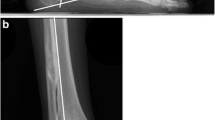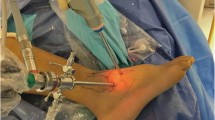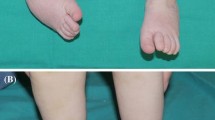Abstract
Between 1988 and 2003, 23 patients with paralytic calcaneus-valgus feet were submitted to the Westin procedure and 17 patients (25 feet) were re-evaluated. Nine patients were male and eight were female. The mean age at the surgical procedure was 8±5 years. The aetiology of paralysis was sequelae of poliomyelitis in 6 patients (8 feet) and of myelomeningocele in 11 patients (17 feet). The mean follow-up period was 6±6 years. The results were analysed clinically and radiographically considering the decrease of the retropulsion, the patient’s satisfaction, and the increase of the lateral tibiocalcaneal angle. Results were considered satisfactory when the patients showed a decrease of the retropulsion during gait, improvement of the gait pattern, and an increase of the tibiocalcaneal angle. As an overall result, 16 patients (94.2%) were satisfied and 1 patient (two feet) dissatisfied with the outcome. The increase of the tibiocalcaneal angle was significant for the myelomeningocele patients (P=0.001), but not for poliomyelitis (P=0.053). No statistical relation between the follow-up period and the increase of the tibiocalcaneal angle was found (r=0.04). The authors concluded that the Westin procedure is a good technique for the treatment of paralytic calcaneus valgus feet with myelomeningocele.
Résumé
Entre 1988 et 2003, 23 patients présentant un pied valgus paralytique ont été traités par le procédé de Westin et 17 patients (25 pieds) ont été évalués. Neuf patients étaient de sexe masculin et huit de sexe féminin. L’âge moyen à l’intervention a été de 8 ans ±5 ans. L’étiologie de la paralysie était surtout une séquelle de polio dans six cas (8 pieds), un myéloméningocèle chez 11 patients (17 pieds). Le suivi moyen a été de 6 ans ±6. Les résultats ont été analysés cliniquement et radiographiquement. Les résultats ont été considérés comme satisfaisants lorsque les patients ont présenté une diminution de la rétropulsion durant la marche avec une amélioration de la boiterie et une augmentation de l’angle tibiocalcanéen. Seize patients (94.2%) ont été satisfaits et un patient (deux pieds) satisfait. L’augmentation de l’angle tibiocalcanéen a été significatif chez les myloméningocèle (P=0.001) alors qu’il n’était pas significatif sur les pieds polio (P=0.053). Aucune relation statistiquement significative n’a été trouvée entre la période de suivi et l’amélioration de l’angle tibiocalcanéen (r=0.04). Les auteurs concluent que le procédé de Westin est une bonne technique pour le traitement des pieds valgus paralytiques chez le myéloméningocèle.



Similar content being viewed by others
References
Menelaus MB, Barwood SA, Graham HK (1998) In: Menelaus’ orthopaedic management of spina bifida cystica, 3rd edn. WB Saunders Co. Ltd, p 107–127
Bliss DG, Menelaus MB (1986) The results of transfer of tibialis anterior to the heel in patients who have a myelomeningocele. J Bone Jt Surg Am 68:1258–1264
Bradley GW, Coleman SS (1981) Treatment of calcaneocavus deformity. J Bone Jt Surg Am 63:1159–1166
Coleman SS (1983) Complex foot deformities in children. Lea & Febiger, pp 167–191
Fernandez FR, Fernandez SA, Colon C, Ramirez N, Alegria M, Clinton R (1992) Transfer of the tibialis anterior for calcaneus deformity in myelodysplasia. J Bone Jt Surg Am 73:1038–1041
Mitchell GP (1977) Posterior displacement osteotomy of the calcaneus. J Bone Jt Surg Br 59:223–235
Cholmeley JA (1953) Elmslie’s operation for the calcaneus foot. J Bone Jt Surg Br 35:46
Fraser RK, Hoffman EB (1992) Calcaneus deformity in the ambulant patient with myelomeningocele. J Bone Jt Surg Am 73:994–997
Frawley PA, Broughton NS, Menelaus MB (1998) Incidence and type of hindfoot deformities in patients with low-level spina bifida. J Pediatr Orthop 18:312–313
Herndon CH, Strong JM, Heyman CH (1956) Transposition of tibialis anterior in the treatment of paralytic talipes calcaneus. J Bone Jt Surg Am 38:751–760
Stevens PM, Toomey E (1988) Fibular-Achilles tenodesis for paralytic ankle valgus. J Pediatr Orthop 8:169–175
Stott NS, Zionts LE, Gronley JK, Perry J (1996) Tibialis anterior transfer for calcaneal deformity a postoperative gait analysis. J Pediatr Orthop 16:792–798
Westin GW (1965) Tendon transfers about the foot, ankle, and hip in the paralyzed lower extremity. J Bone Jt Surg Am 47:1430–1443
Westin GW, Dingeman RD, Gausewitz SH (1988) The results of tenodesis of tendon Achilles to the fibula for paralytic pes calcaneus. J Bone Jt Surg Am 70:320–328
Beaty LH, Canale ST, Roach JW, Dias LS, Drennan JC, Banta JV, Lubicky JP, Carroll NC, Lindseth RE (1990) Orthopaedic aspects of myelomeningocele. J Bone Jt Surg Am 72:626–630
Sharrard WJ (1967) Paralytic deformity in the lower limb. J Bone Jt Surg Br 49:731–747
Dias LS (1983) In: Myelomeningocele, orthopaedic treatment. Williams and Wilkins, p 168
Dias LS (1985) Valgus deformity of ankle joint. Pathogenesis of fibular shortening. J Pediatr Orthop 5:176–180
Carrol NC (1987) Assessment and management of the lower extremity in myelodysplasia. Orthop Clin North Am 18:709–724
Banta JV, Sutherland DH, Wyatt M (1981) Anterior tibial transfer to the os calcis with Achilles tenodesis for calcaneal deformity in myelomeningocele. J Pediatr Orthop 1:125–130
Warner WC (2002) In: Campbell’s Operative Orthopaedics, 10th edn. Mosby Inc., pp 1211–1279
Renington RD, Schork MA (1970) In: Statistics with applications to the biological and health sciences. Prentice Hall Inc., New Jersey, p 418
Georgiadis GM, Aronson DD (1990) Posterior transfer of the anterior tibial tendon in children who have a myelomeningocele. J Bone Jt Surg Am 72:392–398
Hayes JT, Gross HP, Dow S (1964) Surgery for paralytic defects secondary to myelomeningocele and myelodysplasia. J Bone Jt Surg Am 46:1577–1597
Jacobs JT (1966) Achilles tenodesis for paralytic calcaneocavus foot. Clin Orthop Rel Res 47:143–149
Author information
Authors and Affiliations
Corresponding author
Rights and permissions
About this article
Cite this article
Fucs, P.M.M.B., Svartman, C., Santili, C. et al. Results in the treatment of paralytic calcaneus-valgus feet with the Westin technique. International Orthopaedics (SICO 31, 555–560 (2007). https://doi.org/10.1007/s00264-006-0214-8
Received:
Revised:
Accepted:
Published:
Issue Date:
DOI: https://doi.org/10.1007/s00264-006-0214-8




